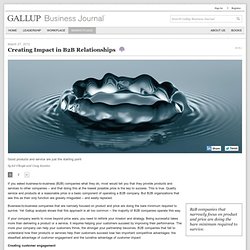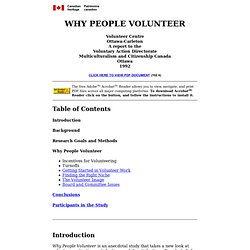

Giving Commitment: Employee Support Programs and the Prosocial Sensemaking Process. Author A. M. Grant, J. E. Dutton, Brent D. Source Academy of Management Journal Vol. 51, No. 5 Publisher Academy of Management Journal Category Leadership and Management Development Corporate Responsibility in the Workplace The objective in this article is to fill this gap by offering an expanded view of the other-interested mechanisms through which employee support programs cultivate affective organizational commitment. Researchers in this article have assumed that employee support programs cultivate affective organizational commitment by enabling employees to receive support.
Researchers find that giving strengthens affective organizational commitment through a “prosocial sensemaking” process in which employees interpret personal and company actions and identities as caring. Self-determination theory. In the 1970s, research on SDT evolved from studies comparing the intrinsic and extrinsic motives, and from growing understanding of the dominant role intrinsic motivation played in an individual’s behavior[2] but it was not until mid-1980s that SDT was formally introduced and accepted as a sound empirical theory.

Research applying SDT to different areas in social psychology has increased considerably since the 2000s. Key studies that led to emergence of SDT included research on intrinsic motivation.[3] Intrinsic motivation refers to initiating an activity for its own sake because it is interesting and satisfying in itself, as opposed to doing an activity to obtain an external goal (extrinsic motivation). Different types of motivations have been described based on the degree they have been internalized. Internalization refers to the active attempt to transform an extrinsic motive into personally endorsed values and thus assimilate behavioural regulations that were originally external.[4] Creating Impact in B2B Relationships. If you asked business-to-business (B2B) companies what they do, most would tell you that they provide products and services to other companies -- and that doing this at the lowest possible price is the key to success.

This is true. Quality service and products at a reasonable price is a basic component of operating a B2B company. But B2B organizations that see this as their only function are gravely misguided -- and easily replaced. B2B companies that narrowly focus on product and price are doing the bare minimum required to survive. Business-to-business companies that are narrowly focused on product and price are doing the bare minimum required to survive. If your company wants to move beyond price wars, you need to rethink your mission and strategy. Creating customer engagement Customer engagement goes beyond merely satisfying customers to provide an important foundation for creating customer impact. Creating customer impact This advice-based approach deepens a customer relationship.
Why People Volunteer. Volunteer Centre Ottawa-Carleton A report to the Voluntary Action Directorate Multiculturalism and Citizenship Canada Ottawa 1992 CLICK HERE TO VIEW PDF DOCUMENT (102 k) Table of Contents Introduction Background Research Goals and Methods Why People Volunteer Conclusions Participants in the Study Introduction Why People Volunteer is an anecdotal study that takes a new look at volunteer motivation, satisfactions and dissatisfactions.

The study was funded by the Voluntary Action Directorate of Multiculturalism and Citizenship Canada. Special thanks to Marion Porter for her help and support. Background Over the last few years many social and health service agencies have found it increasingly difficult to find enough volunteers to carry out their many programs, especially during daytime hours. Competition for volunteers Managing a scarce resource It has become more important than ever to improve the way we manage this scarce and valuable resource.
A satisfied volunteer is the best recruiter 6 Family ties. The HBR Interview: “We Had to Own the Mistakes” By the time Howard Schultz stepped down as chief executive of Starbucks, in 2000, the coffee chain was one of the world’s most recognizable brands—and on a steady trajectory of growth. Eight years later Starbucks was suffering from a rough economy and its own strategic missteps, and Schultz felt compelled to return to the CEO seat. His previous tenure had seen promising growth, but now he faced a challenging mission: to lead a turnaround of the company he had built. In this condensed and edited interview, Schultz discusses what it’s like to retake the reins in the middle of a crisis. HBR: We thought we knew the Howard Schultz story.
You had a vision, built a successful company, and moved on. Schultz: The past two years have been transformational for the company and, candidly, for me personally. To what extent did the financial crisis add to the management crisis? For some reason we seemed to become the poster child for excess. Also, you were suddenly facing serious competition. Ivan Illich: To Hell With Good Intentions.